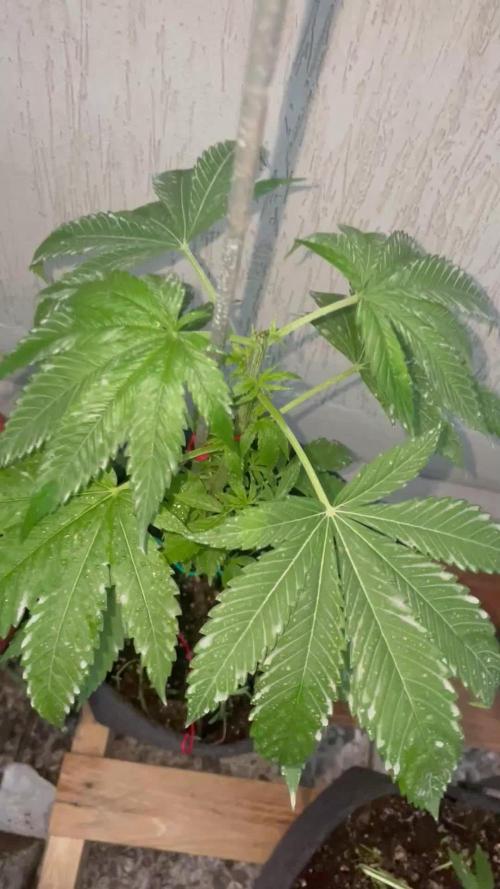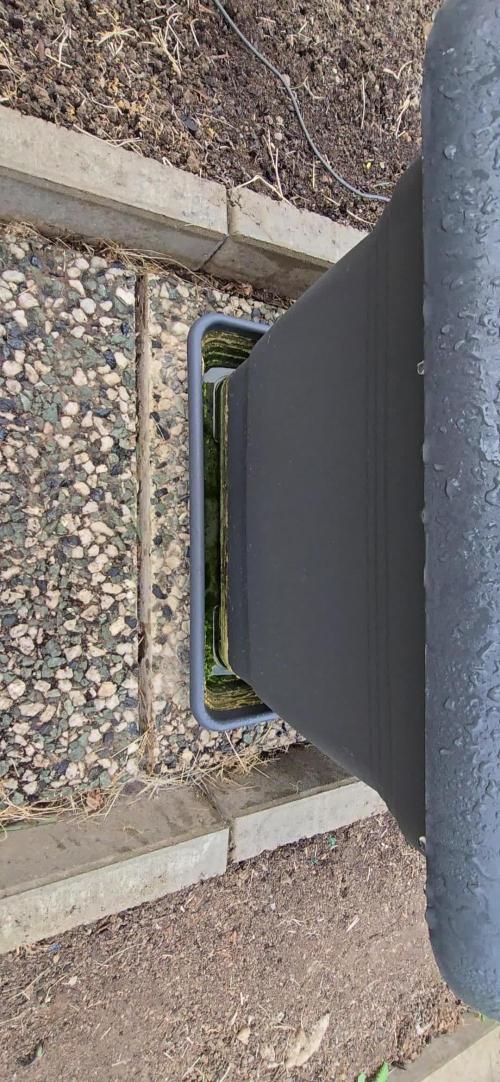By continuing to use the website or clicking Accept you consent to our cookies and personal data policy and confirm that you are at least 18 year old. For details please see Privacy Policy and Terms
Accept
Likes
10
Share


@Naturalist
Follow
Defoliated on day 82.
Flowers are starting to get sticky on sugar leaves & the pine smell is picking up but not as strong as expected the Gelato buds are starting to amber up.
Think I'm going to up the Foliage Pro a ml as is see some yellowing since I switched up the ratio.
Likes
7
Share


@BabyBillyFreeman
Follow
She handles the stress quite well. No herms in sight so far. Buds forming. Nice sweep terps
Likes
35
Share


@Theia
Follow
Forgive my language but I fucking love this plant. She is just a beast only restricted by the 5l pot I shackled her to.. but considering the pit size the main on this thing is offensive! It is a dirty great big donkey dong that smells like fresh fruit.. I'm confused 😜😜.
She needs another 2 weeks to finish I think but because of how fat her main is I'm quite concerned about rot. I've set triggers to keep my room at 50% and temps at 24c. I'm getting within +/- 2c and Rh is actually more like a 48%.
I will ease off the feeds of npk after the next feed which will be around a 1.5ec. then she will get just water ..
Thanks for stopping by on my strawberry adventure.
Grow well 👍🏼💚🌿🇬🇧
Likes
29
Share


@Grileon
Follow
Did another topping today. Hope there will be 8 strong main branches.
Also raised temperature and humidity a little and plant looks much better now. Roots still healthy and white.
UPDATE:
Did defoliation for big fan leaves and LST for all 8 branches.
Likes
2
Share


@KeemBboomin
Follow
Once again, we are cruising through week three there’s nothing to do but water one dry and keep their favor bop music playing
Likes
36
Share


@GreenHouseLab
Follow
Another week for sure on both will be cutting out the calmag as they start fading.
Likes
31
Share


@MrRaid
Follow
Hello everyone my 5x5 grow is starting and here's the details 🍻👍
7x 11l pruning pots/1x airport 10l
Soil: Bio Bizz light mix
Nutrients: Sensi Bloom A&B, Terpinator, overdrive, carbo voodoo juice and maybe some rhino skin
Light: Spider Farmer 4000 Heard good things
about it
Tent: 5x5 BudBox
Water supply: tap water I let sit for 24 hours
Ventilation: 8ich ram fan was gonna get the stealth phresh but yeh got a pillow wrapped on it to reduce noise using 8inchto12inch carbon filter and a 16ich standing fan on day 19 I will be adding 2x co2 bags 🍻🍻🍻 that's basically everything oh my ph stays at 6.5 👍💪🍄
13th December 2019
All 8 seeds sprouted
Plain water ph to 6.3
One of my watering was abit highPH as I didnt check the ph but hasn't done any harm my expectations for this grow realistically I should easy get 20oz of dence buds but I would be happy and content with 17oz but this light I'm using is the best I've ever used very expensive to me £500 for 1 light I know theres more expensive but this is a upgrade for me considering I was using Mars hydro 300 and cheap cheap China led my ak47 grow was done with really bad lights and it looks like it didn't yeild that bad I had to throw my BlackBerry kush and stardawg in the tent hope they dont take to much room lol ik these cookies are gonna grow nice and big under that light 🥂
Likes
2
Share


@Mr_nugs_lover_David
Follow
Very sticky snd dense nuggets,tons of resin in this autoflowering strains, they are high quality, as you guys can see both wedding cakes auto by original sensible seeds have the exact same resin production, very frosty both, very sticky and big fat main colas with all the buds from the lower plant are also fat, dense and sticky, just a dream come true 💎 very good automatic strain, doesn't even looks like an auto, super sticky and a very pure and strong aroma, she's been fed with only organic dry amendments by guanokalong complete organics and seaweed powder and florganics that's how I prepared her soil. Thank you so much everybody hope you like another diary of frosty cookies 🍪🤤🍭🌸✌️💚❤️
Likes
3
Share


@Muxa752
Follow
Все идет по плану , шишки пухнут ,появился характерны запах , в целом идет ленивый гров . подчищаю листву понемногу , стабильный полив ,хорошие условия , больше ничего не нужно )
Likes
Comments
Share


@fattiniwtk
Follow
Ciao a tutti, aggiornamento alla quinta settimana, le due golosa durante la quarta sono cresciute molto raddoppiando.
Ho fatto un topping alla #3 mentre ho applicato LST alla #2, essendo più cespugliosa la luce penetrerà meglio. Infine ho usato zeolite per fare prevenzione.
Per il momento non mostrano carenze e stanno rispondendo bene agli stress.
Buon cultivo 🌱
Likes
11
Share


@Budking420
Follow
This weeks been hot and dry. I've been doing everything I can to keep humidity up. I havent been feeding as much but lots of watering. Some defoliation but not very much. The bud sites are plentiful & numerous. The top sites have long pistols so I expect her to have large swelling buds. The strawberry gorilla seems to crave lots of sunlight so to say so keep the LED near max for best results! Check back next week to see just how fast she grows & remember its 4:20 somewhere!!!!
Processing
Likes
7
Share


@SirBongsWorth
Follow
This phase is not veg, I am new to this site so navigation is new to me. Please note "actual" time is a week ahead of my time line. That said, nothing exciting this week. The seeds sat in water for 48 hours then planted in soil. Three days later like all my seeds I plant, they were officially seedlings. Just when I thought everything was good, some bugs had to come and ruin my day! Stay tuned for next week and my battle against thrips!
Likes
10
Share


@Jozef_Balcerek
Follow
Podlewane woda PH 7.0 żeby podnieść PH ziemi, rośliny są przyblokowane ale jestem dobrej myśli, gdyż pomału wraca do prawidłowych wartości Zaczęło się kwitnienie. Warunki są stabilne 25-26C wilgotność 60-65%. Pozdrawiam odwiedzających. Jesli macie jakies uwagi albo propozycje piszcie w komentarzach . Dziekuje :-)
Likes
10
Share


@mr_smooke
Follow
Here we are on day 28.
On day 23 i spoted Spider Mites. Next day i been spray leavs whit neem oil, for now SM are gone i hope they will not come back. She coming along nicely😁🤩🤘✌️
Likes
5
Share


@pzwags420
Follow
I had to top Cantaloupe haze and White widow as they were too close to the lights and I didn't want to loose any ppfd on my lowers. My GSC seems perfect for not topping. next time I would top those strains at least once. I have been flushing the CH and getting run off around 1200ppm which seems like the max she can take the others like it stronger so I have been flushing them every 2-3 days. CH is tough to keep happy but will continue to monitor. All plants are in week 4 of flower 12/12 from seed.
Likes
13
Share


@NSABND
Follow
Let´s start a new week 😎👌
Day36 very sunny and warm... "Hilde 2.0" goes well 😎👍🙏
Day37 starts with massive cloudy weather but later it turns into a sunny afternoon 😏🙏
Day38 was cloudy and rainy and not so much sun around here 😳😵
Day39 damn cloudy and rain....wth is this summer doing 😵😧
Day40 wth is wrong with this summer 😡 cloudy and rain and no sun 😵😨































